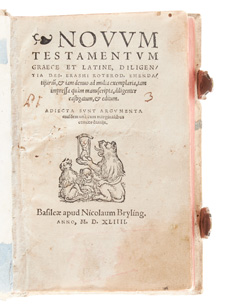182: BILDERBIBELN – NEUES TESTAMENT – NATALIS (NADAL), H.,
Erste Ausgabe. – STC 33 (als Tl. II der "Adnotationes et meditationes in evangelia"). Adams N 56. De Backer/Sommervogel V, 1518. Funck 196 und 366. Palau 187148. Mauquoy-Hendrickx, Les Wierix illustrateurs de la Bible dite de Natalis, 26-64. – Erstdruck des separaten Tafelteiles, zu dem ein Jahr später die "Anmerkungen und Meditationen zu den Evangelien" (Adnotationes et meditationes in evangelia) erschienen. – Obwohl das Werk erst 37 Jahre nach dem Tode des Ignatius von Loyola veröffentlicht wurde, war es schon lange vor seiner Publikation inhaltlich konzipiert. Ignatius stand mit Nadal in persönlichem Kontakt und übte einen starken Einfluß auf die Gestaltung des Buches aus. Das Werk steht daher in ganz direktem Zusammenhang mit den Zielvorstellungen der frühen katholischen Reformbewegung und der Gegenreformation. Es begründet eine neue religiöse Kunstform, die die Eignung der Kunst zu religiöser Unterweisung nutzte. Es war das erste Betrachtungsbuch der Jesuiten nach den "Geistlichen Übungen" (Exercitia spiritualia) des Ignatius und wurde bald das am meisten geschätzte Unterrichtswerk der Jesuitenmissionare, besonders in China.
In dieser ersten Ausgabe finden sich der Name des Zeichners Bernardino Passeri auf allen Tafeln, ausgenommen jene, die nach Martin de Vos gestochen wurden. "Cette suite est l’une des plus belles séries de gravures du seizième siècle flamand et l’une des grandes oeuvres de l’art graphique … cet ouvrage est exceptionnel. Les effets de foules, les profondeurs des champs, la profusion des détails, significatifs sans nuire à l’ensemble, l’éclairage enfin, tout concourt à faire de ces gravures de véritables chefs-d’oeuvre" (Berès, Cat. 71, 176). – Titelei, Text und Tafeln bis zum Bild – oder Textrand beschnitten und Mitte des 17. Jahrhunderts passepartoutartig in einen Papierrahmen geklebt. – Fliegende Vorsätze entfernt, die Tafeln 115, 125 und 126 mit kleiner Fehlstelle in der Darstellung, wenige Unterlageblätter mit tls. hinterlegten Randeinrissen, die Stiche gering fleckig, die Ränder tls. gebräunt und etw. fleckig. – Exemplar in dekorativem Wappeneinband, abgebildet bei Olivier 1468, 1, einem Mitglied der Familie Lotin de Charny zugeschrieben (nach Guigard II, 330).
First edition. – First print of the separate plate part, one year later the "Notes and meditations to the gospels" (Adnotationes et meditationes in evangelia) were published. – Although the work was published only 37 years after the death of Ignatius of Loyola, the content had been structured long before its publication. Ignatius stayed in personal contact with Nadal and had a strong influence on the structuring of the book. The work therefore is closely associated with the objectives of the early Catholic reform movement and Counter-Reformation. It justifies a new religious art form that used the suitability of the art for religious instruction. It was the first book of meditation of the Jesuits after the "Spiritual exercises" (Exercitia spiritualia) by Ignatius and soon became the most popular textbook of the Jesuit missionaries, particularly in China. – Prelims, text and plates cut up to illustration border or text margin, glued like a passe-partout in a paper frame in the mid-17th century. – Fly-leaves removed, plates 115, 125 and 126 with small defect in illustration, a few support sheets with partly backed marginal damages, the engravings minimally soiled, margins partly browned and a little soiled. – The copy in a decorative heraldic binding, depicted by Olivier 1468, 1, attributed to a member of the family Lotin de Charny (after Guigard II, 330). – Red morocco of the 17th century with spine title, gilt back and armorial supralibros on both covers as well as gilt outside and interior edges (joints and corners professionally restored, a little rubbed and scuffed).



